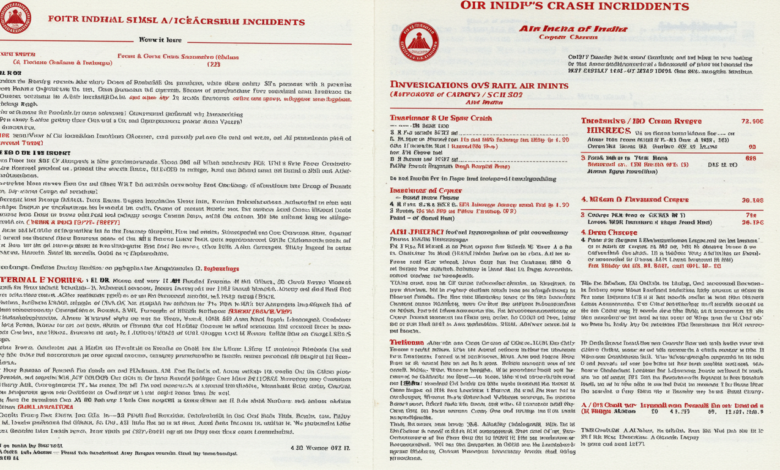Air India Plane Crash Reports: A Comprehensive Analysis

Introduction
Air India, the flag carrier of India, has experienced several tragic incidents over its history, including plane crashes that have affected passengers and the aviation industry deeply. Understanding Air India plane crash reports is crucial for safety analysis, regulatory improvements, and honoring the victims.You know about theglobespot, andaazdaily, openrendz and air india plane crash reports also Buzzfeed.
This article examines the history of Air India crashes, details of major incidents, investigation reports, causes, lessons learned, and changes implemented in aviation safety. It offers a thorough, reader-friendly account suitable for aviation enthusiasts, researchers, and concerned citizens.
Air India: An Overview
Founded in 1932, Air India is one of Asia’s oldest airlines. Over decades, it grew to operate domestic and international flights. With increasing air traffic, Air India faced the challenges common to many carriers, including occasional accidents.
History of Air India Plane Crashes
Though Air India boasts a strong safety record today, the airline has faced a number of unfortunate crashes and incidents. Reviewing these events offers valuable insight.
Major Air India Plane Crashes
1. Air India Flight 182 (1985)
Incident: On June 23, 1985, Air India Flight 182 exploded mid-air off the coast of Ireland. The Boeing 747 was en route from Montreal to London and then to Delhi and Bombay.
Casualties: All 329 people onboard died, marking the deadliest aviation disaster involving a Canadian flight and the worst terrorist attack on an aircraft before 9/11.
Cause: Investigation revealed a bomb placed in checked luggage, linked to Sikh extremists. This led to significant security overhauls worldwide.
2. Air India Express Flight 812 (2010)
Incident: On May 22, 2010, a Boeing 737 operating flight IX812 crashed while landing at Mangalore airport, a tabletop runway in India.
Casualties: 158 of 166 passengers and crew died, with only 8 survivors.
Cause: Investigation pointed to pilot error and failure to abort landing despite overshooting the runway. This crash highlighted the challenges of operating in difficult terrain airports.
3. Air India Flight 101 (1966)
Incident: Flight 101, a Boeing 707, crashed into Mont Blanc in the French Alps during a Paris to Bombay flight.
Casualties: All 117 onboard died.
Cause: The cause was attributed to navigation errors and poor weather conditions. It raised awareness about the need for better navigational aids.
Common Causes in Air India Plane Crashes
Terrorism and Security Lapses
The bombing of Flight 182 exposed gaps in security screening. The tragedy led to international cooperation for better aviation security.
Pilot Error and Human Factors
Flight 812 crash showed how human error, particularly in high-stress situations, can lead to disaster.
Weather and Terrain Challenges
Several crashes occurred due to adverse weather and difficult geography, demanding specialized training and better equipment.
Mechanical Failures
Though less common in Air India crashes, mechanical issues sometimes contributed.
Investigation and Reports
Air crash investigations are thorough and involve multiple agencies. The Directorate General of Civil Aviation (DGCA) in India and international bodies examine evidence including:
-
Flight data recorders (black boxes)
-
Cockpit voice recorders
-
Wreckage analysis
-
Weather reports
-
Air traffic control communications
-
Passenger and crew records
Reports are detailed, highlighting causes and recommending safety improvements.
Impact on Aviation Safety
Each Air India crash prompted changes in aviation policies:
-
Enhanced airport security protocols
-
Improved pilot training programs
-
Advanced navigation systems
-
Regulations for tabletop runways
-
International collaboration on anti-terrorism measures
These changes have saved countless lives worldwide.
Air India’s Response and Measures Taken
After each tragedy, Air India invested in safety:
-
Upgraded fleet with newer aircraft
-
Implemented rigorous safety audits
-
Focused on crew resource management
-
Established emergency response teams
-
Engaged with global aviation safety organizations
Case Study: Flight 182 Terror Attack and Its Legacy
The bombing was a pivotal moment in aviation history. It led to:
-
Strengthened baggage screening internationally
-
Intelligence sharing between countries
-
Creation of new anti-terror laws
-
Victim compensation frameworks
Current Safety Record of Air India
Today, Air India is committed to maintaining a strong safety record. It has:
-
Modernized its fleet
-
Adhered to International Civil Aviation Organization (ICAO) standards
-
Maintained transparent reporting and compliance with safety audits
-
Encouraged a safety culture among staff and passengers
Lessons Learned from Air India Plane Crash Reports
The tragedies underline several lessons:
-
Vigilance against security threats is paramount
-
Human error must be minimized through training
-
Airports in difficult locations require special protocols
-
Technology plays a critical role in accident prevention
-
Transparent and timely investigations foster trust
The Role of Technology in Preventing Crashes
Modern aircraft feature advanced avionics, autopilot systems, terrain awareness, and collision avoidance technology. Air India has incorporated these advancements to reduce risks.
The Psychological and Social Impact
Beyond technical analysis, plane crashes deeply affect families, communities, and nations. Air India has supported victims’ families and improved passenger communication during crises.
Conclusion
The Air India plane crash reports are tragic chapters with hard-earned lessons. They showcase the complex nature of aviation safety. By studying these incidents, airlines, regulators, and passengers can work together to make flying safer.



